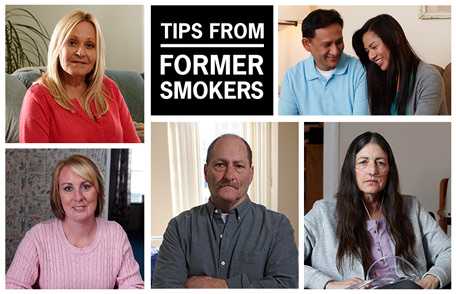Tips Ads Still a Best Buy for Public Health
 Ads continue in 2017 to encourage smoking cessation.
Ads continue in 2017 to encourage smoking cessation.
For more than five years, CDC’s Tips From Former Smokers™ campaign has brought compelling messages designed to not only encourage smokers to quit, but to show them the faces and lives of real people who have been negatively impacted by cigarette smoking.
You might recall that the first ads were launched in March of 2012, and may even remember Terrie Hall, one of the former smokers featured in the Tips campaign. Terrie shared her story of how smoking since the age of 13 led to her diagnosis of oral and throat cancer. By telling others about her experience, Terrie, like the 34 other campaign participants, share in the Tips legacy of saving thousands of lives.

In the spring of 2016, Tips participants gathered in Washington, DC, with leaders from partner groups and organizations for a panel discussion about the powerful effects of the Tips Campaign and to share personal stories and perspectives.
Starting January 9 and continuing through the first half of 2017, Tips ads will run nationally on broadcast and cable TV, in magazines, and online. The 2017 campaign features a variety of ads from past years, focusing on diseases and conditions such as throat and lung cancer, heart attack, stroke, periodontal disease, asthma, and chronic obstructive pulmonary disease. The goals of the 2017 campaign will remain the same as in previous years— to build public awareness of the damage caused by smoking and exposure to secondhand smoke; to encourage smokers to quit and make free help available; and to encourage smokers not to smoke around others and nonsmokers to protect themselves and their families from exposure to secondhand smoke.
In the years since the Tips campaign launched, the results have exceeded expectations. During 2012-2015, more than 5 million smokers attempted to quit because of the campaign, with more than 500,000 of those people estimated to have quit for good. One person commented on social media,
“I am 41 years old and have smoked a pack a day for 26 years. I always knew I needed to quit. I can barely breathe and my heart races at the slightest movement. I am now for the first time in 26 years smokefree. I thank you for those scary commercials, and I thank Terrie for allowing her story to be told. I quit and I owe it to her.”
The campaign was built on research in which CDC learned that, while smokers knew that their smoking may ultimately kill them, they thought less about living with the health damage caused by their smoking. Some smokers reported that they needed to see and hear what it would be like to live with the health consequences of smoking in order to motivate them to try and quit. Actually seeing how smoking could affect their lives and impact their families was extremely powerful. Another person made the social media comment,
“I just want to thank you guys for saving my life. Watching the ads helped me quit. You added time to my life and are Godsend just from telling the truth and showing what can really happen to those who unknowingly indulge in a lethal killer. Thank you!”
 Through research and evaluation, CDC also learned that:
Through research and evaluation, CDC also learned that:
- Hard-hitting media campaigns are effective in helping people quit smoking.
- Emotionally evocative tobacco education media campaigns featuring graphic images of the health effects of smoking can increase quitline calls and website visits.
- Each year while the campaign was on the air, there was an immediate, sustained and dramatic spike in calls to 800-QUIT-NOW, and in visits to the campaign website.
- The Tips campaign is cost-effective—for every $3,000 we spend on the ads, we prevent a premature death; or, for every $400 we spend on the ads, we prolong someone’s life by at least a year.
The Tips campaign continues to be a best buy for public health. If you smoke or know someone who smokes, the following free assistance is available to help with quitting:

- 1-800-QUIT-NOW (1-800-784-8669) or 1-855-DÉJELO-YA (1-855-335-3569) (for Spanish speakers). This free service offers a lot of resources, including coaching, help with making a quit plan, educational materials, and referrals to other resources where you live.
- The Asian Smokers’ Quitline is a free nationwide Asian-language service that offers self-help materials, referral to local programs, one-on-one telephone counseling, and free NRT medication.
- Chinese: 1-800-838-8917
- Korean: 1-800-556-5564
- Vietnamese: 1-800-778-8440
- Smokefree TXT. This free 24/7 texting program sends encouragement, advice, and tips to help smokers quit smoking for good. To get started, just text QUIT to 47848, answer a few questions, and you’ll start receiving messages.
- Online help. This Tips From Former Smokers web page provides helpful online quit resources.
- Smokefree App. The QuitGuide is a free app that tracks cravings, moods, slips, and smokefree progress to help you understand your smoking patterns and build the skills needed to become and stay smokefree.
- Page last reviewed: January 11, 2017
- Page last updated: January 11, 2017
- Content source:
- National Center for Chronic Disease Prevention and Health Promotion
- Page maintained by: Office of the Associate Director for Communication, Digital Media Branch, Division of Public Affairs




 ShareCompartir
ShareCompartir